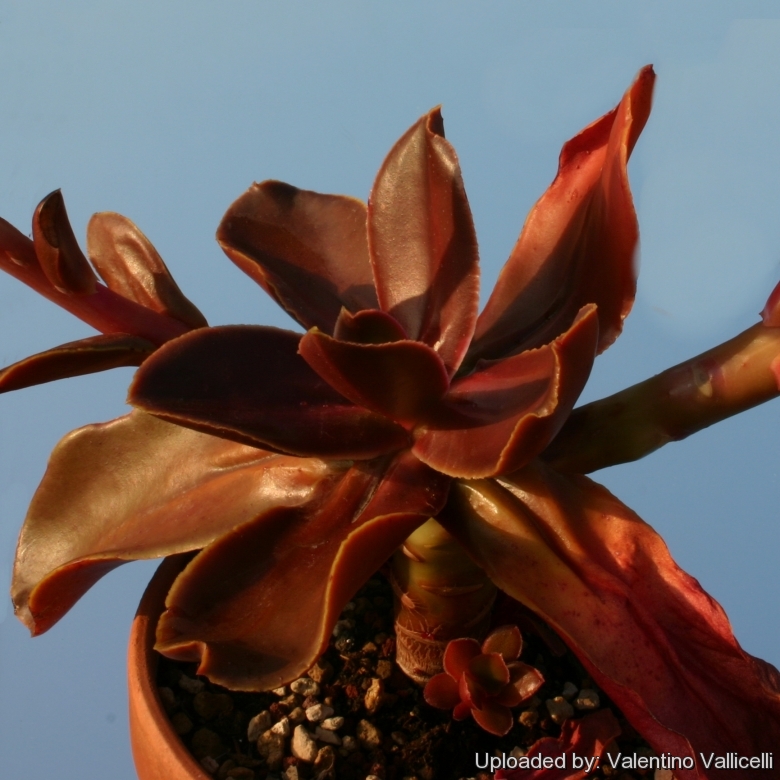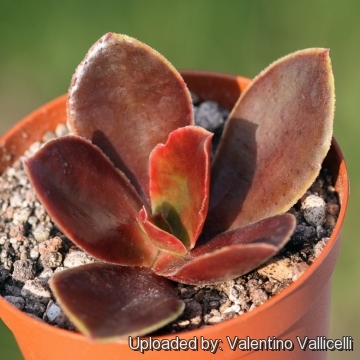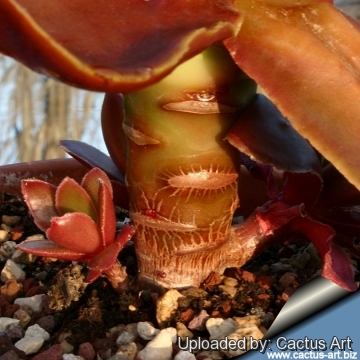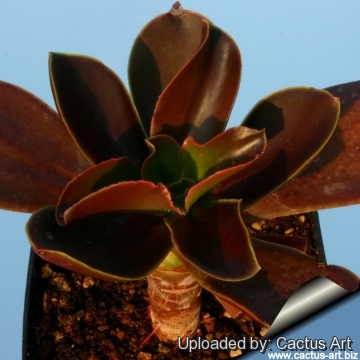
Echeveria atropurpurea Photo by: Valentino Vallicelli
Origin and Habitat: Central Veracruz (Comapa, Jalcomulco, Paso del Macho, Tlaltetela y Totutla), Mexico.
Habitat: Tropical deciduous forests. The species is threatened by habitat loss, which is shrinking rapidly.
Synonyms:
See all synonyms of Echeveria atropurpurea
back
Accepted name in llifle Database:Echeveria atropurpurea (Baker) E.MorrenAnn. Hort. Belge Étrangère 24: 156Synonymy: 3
back
Common Names include:
SPANISH (Español): Chapetona, Siempreviva
Description: Echeveria atropurpurea is a well-marked showy plant, with short, stout, stems and dark-purple oblongue leaves, covered with a glaucous bloom. It produces striking red flowers in winter.
Stem: Robust, usually unbranched, glabrous, 10-15 cm in height (eventually to 20 cm long) and approx 2-2,5 cm in diameter.
Rosette Somewhat lax to dense, of about 20 leaves at the top of the stem and a width of approximately 25-40 cm.
Leaves: 10-12 cm long, 3-5 cm wide, glabrous, oblong or obovate-spathulate, deeply channeled, the base broad for the genus, the texture moderately thick, the upper surface especially dark purple-green or brownish-red with a glaucous bloom. Margin entire.
Inflorescence (raceme): Flowering-stems erect, 30-60 cm tall, with leaf-like bracts but smaller, terminating in a long raceme with 20-25 flowers to each raceme,
Flowers: Sepals 4 mm long, dark-green united at the base, almost equal, lanceolate, spreading to swept back. Corolla pentagonal to 12 mm long, pink-orange (salmon) to bright red. Petals orange. Segments pointed, the outer row of stamens inserted about half-way down. It is polycarpic, which means that it is able to set seeds and flowers for several years across its entire lifetime.
Blooming season: It flowers from July to February, mostly in winter and blooms last nearly three months.
Seeds: Numerous, dark brown.
Related species: Since E. atropurpurea presents a racemose inflorescence with long and bracteolate pedicels, it has affinities with Echeveria uxorium, Echeveria penduliflora and Echeveria caniculata, due to the caulescent habit and somewhat lax rosette.
Bibliography: Major referencens and further lectures
1) Gardeners Chronicle & New Horticulturist, Volume 31 Haymarket Publishing, 1871
2) Bessie Wilson Raymond Buxton, Mrs. Bessie Wilson (Raymond) Buxton “The Window Garden: A Practical Manual on Soils, Propagation, Potting and General Care of House Plants” Orange Judd publishing Company, Incorporated, 1936
3) Eric Walther “Echeveria” California Academy of Sciences, 1972
4) Hermann Jacobsen “A handbook of succulent plants: descriptions, synonyms, and cultural details for succulents other than Cactaceae, Volume 1” Blandford Press, 1960
5) Alfred Byrd Graf “Exotica, series 4 international: pictorial cyclopedia of exotic plants from tropical and near-tropic regions” Roehrs Co. Publishers, 1985
6) John Pilbeam “The Genus Echeveria” British Cactus & Succulent Society, 2008
7) James Cullen, Sabina G. Knees, H. Suzanne Cubey “The European Garden Flora Flowering Plants:A Manual for the Identification of Plants Cultivated in Europe, Both Out-of-Doors and Under Glass” Cambridge University Press, 11/ago/2011
8) Baker, J.G. 1870. Refugium botanicum 3: t. 198.
9) Jimeno-Sevilla, H.D. 2008. "El género Echeveria (Crassulaceae) en Veracruz, México." Tesis de Licenciatura. Facultad de Biología. Universidad Veracruzana. Xalapa, Veracruz, México.
10) Morren, C.J.E. 1874. La Belgique Horticole 156.
11) Walther, E. 1972. "Echeveria." California Academy of Sciences. San Francisco, California, EE. UU.
 Echeveria atropurpurea Photo by: Valentino Vallicelli
Echeveria atropurpurea Photo by: Valentino Vallicelli Echeveria atropurpurea Photo by: Valentino Vallicelli
Echeveria atropurpurea Photo by: Valentino Vallicelli Echeveria atropurpurea Photo by: Valentino Vallicelli
Echeveria atropurpurea Photo by: Valentino Vallicelli Echeveria atropurpurea Photo by: Cactus Art
Echeveria atropurpurea Photo by: Cactus Art Echeveria atropurpurea Photo by: Cactus Art
Echeveria atropurpurea Photo by: Cactus ArtSend a photo of this plant.The gallery now contains thousands of pictures, however it is possible to do even more. We are, of course, seeking photos of species not yet shown in the gallery but not only that, we are also looking for better pictures than those already present.
Read More... Cultivation and Propagation: Echeveria atropurpureaSN|26230]]SN|26230]] is a relatively easy plant thought not the easiest of the echeverias. It makes great potted specimens.
Soil: Use a very porous soil, which will allow quick drainage.
Repotting: If potted, repot them preferably in the spring, if their roots become cramped. Generally, they should be repotted every other year in order to provide fresh soil. However, this doesn't necessarily mean they'll need larger containers. Fill about a quarter of the pot with broken crocks, gravel, etc. to promote good drainage. After repotting, do not water for a week or more. Use pot with good drainage. Eventually, as the plant becomes mature grow it slowly, and adopt a new repotting period, using intervals of every 2 - 3 years. Additionally grow it under drier conditions or with stronger sunlight.
Fertilization: Slow release fertilisers with a low to moderate nitrogen content are adequate for the spring and summer growing seasons, and additional fertiliser applications would not required until spring.
Exposure: It can tolerate sun to shade but - generally speaking - the more light a plant gets the better it will display its colours and shape. However, when moving plants from lower light conditions into full sun, be wary of sun scorch, most easily avoided by ensuring plants are well-watered before moving them on a cloudy day.
Watering: They can tolerate extended dry periods and survive drought without the need for watering, but they will grow stronger if they receive adequate moisture during their growing season, and never allowing the plant to remain waterlogged (root rot sensitive).
Ventilation: Good air movement is important for minimising pest and disease risks, and avoiding excessive humidity in cool winter conditions is important to successfully growing Echeveria in the nursery environment.
Hardiness: It can tolerate light frosts, but it is best overwintered at 5-10 °C.
With the cooler autumn temperatures tending to make their foliage colours become more intense than those of the active summer growing season.
Pest & disease: Aphids like this plant (and all flowering Echeveria).
Maintenance: Remove older dead leaves that build up at the base.
Propagation: New plants form easily from dropped bracts: mother plants rarely branch. If the plant is repotted some of the bottom leaves can be removed, in order to attempt leaf propagation, it is also a common practice to collect the leaves on the flower stem. However this is not one of the easiest species to root, as many such cuttings will dry out without producing a plantlet, but with perseverance it is likely to get a few new plants.















